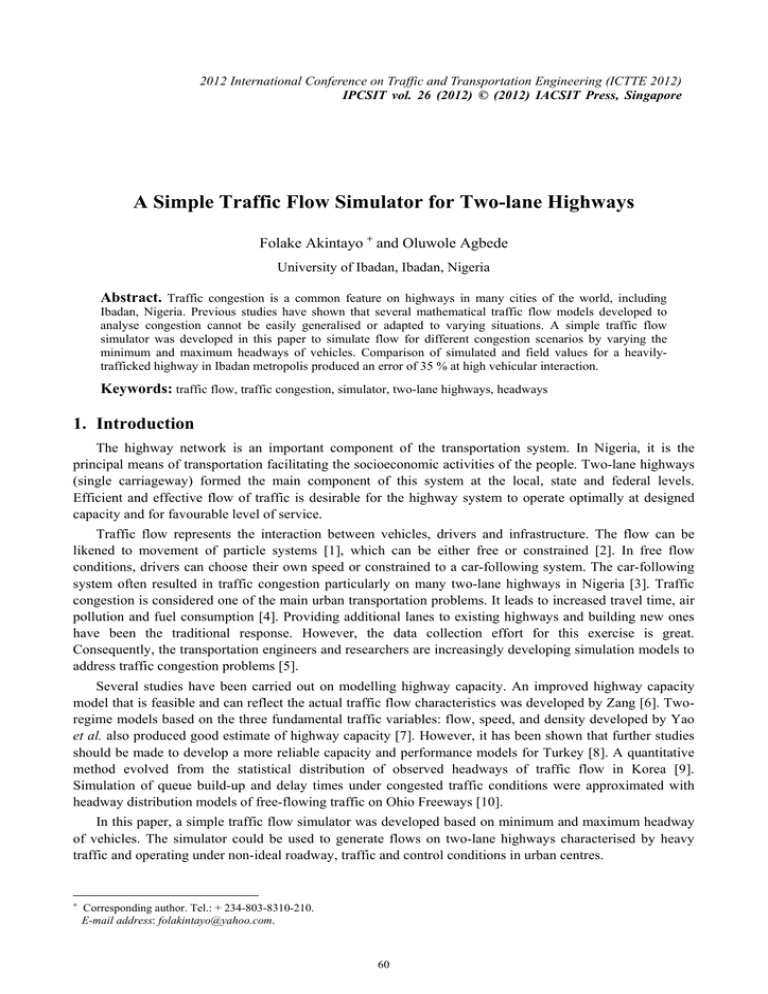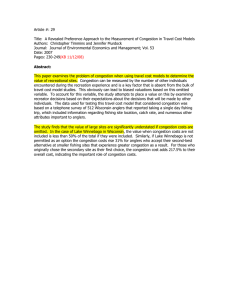A Simple Traffic Flow Simulator for Two-lane Highways Folake Akintayo Abstract.
advertisement

2012 International Conference on Traffic and Transportation Engineering (ICTTE 2012) IPCSIT vol. 26 (2012) © (2012) IACSIT Press, Singapore A Simple Traffic Flow Simulator for Two-lane Highways Folake Akintayo + and Oluwole Agbede University of Ibadan, Ibadan, Nigeria Abstract. Traffic congestion is a common feature on highways in many cities of the world, including Ibadan, Nigeria. Previous studies have shown that several mathematical traffic flow models developed to analyse congestion cannot be easily generalised or adapted to varying situations. A simple traffic flow simulator was developed in this paper to simulate flow for different congestion scenarios by varying the minimum and maximum headways of vehicles. Comparison of simulated and field values for a heavilytrafficked highway in Ibadan metropolis produced an error of 35 % at high vehicular interaction. Keywords: traffic flow, traffic congestion, simulator, two-lane highways, headways 1. Introduction The highway network is an important component of the transportation system. In Nigeria, it is the principal means of transportation facilitating the socioeconomic activities of the people. Two-lane highways (single carriageway) formed the main component of this system at the local, state and federal levels. Efficient and effective flow of traffic is desirable for the highway system to operate optimally at designed capacity and for favourable level of service. Traffic flow represents the interaction between vehicles, drivers and infrastructure. The flow can be likened to movement of particle systems [1], which can be either free or constrained [2]. In free flow conditions, drivers can choose their own speed or constrained to a car-following system. The car-following system often resulted in traffic congestion particularly on many two-lane highways in Nigeria [3]. Traffic congestion is considered one of the main urban transportation problems. It leads to increased travel time, air pollution and fuel consumption [4]. Providing additional lanes to existing highways and building new ones have been the traditional response. However, the data collection effort for this exercise is great. Consequently, the transportation engineers and researchers are increasingly developing simulation models to address traffic congestion problems [5]. Several studies have been carried out on modelling highway capacity. An improved highway capacity model that is feasible and can reflect the actual traffic flow characteristics was developed by Zang [6]. Tworegime models based on the three fundamental traffic variables: flow, speed, and density developed by Yao et al. also produced good estimate of highway capacity [7]. However, it has been shown that further studies should be made to develop a more reliable capacity and performance models for Turkey [8]. A quantitative method evolved from the statistical distribution of observed headways of traffic flow in Korea [9]. Simulation of queue build-up and delay times under congested traffic conditions were approximated with headway distribution models of free-flowing traffic on Ohio Freeways [10]. In this paper, a simple traffic flow simulator was developed based on minimum and maximum headway of vehicles. The simulator could be used to generate flows on two-lane highways characterised by heavy traffic and operating under non-ideal roadway, traffic and control conditions in urban centres. + Corresponding author. Tel.: + 234-803-8310-210. E-mail address: folakintayo@yahoo.com. 60 2. Traffic Flow Simulator (TRAFLOS) 2.1. Algorithm Specify observation period, T to simulate traffic congestion scenario. For a particular scenario, specify h1 and h2 as the minimum and maximum headways respectively. Generate random variates hn such that: h1≤ hn< h2 and VR = ∑ n = k c T (1) where; VR= number of vehicles (n) released per simulation run kc = congestion factor ; T = the total headway in seconds/observation period. The flow chart for the steps above is shown in Fig. 1. The algorithm developed above was coded in JAVA programming language. It has Graphical User Interface (GUI) that provides the user with text fields for the experiment parameters and a button to initiate the experiment. An “exit” button is also provided to close the application. The progress of the experiment is shown on a white pad in the interface which shows headways as they are generated and the vehicle releases with the time each vehicle was released. Another white pad shows the summary of the experiment at the end of each run. Specify observation period, T define h1 and h2 generate random variates, hn no ∑hn=T? yes end Fig. 1: Traffic Flow Simulator (TRAFLOS) Flowchart 2.2. Congestion scenarios design Based on the preliminary traffic study on three heavily trafficked two-lane roads (Total Garden-Agodi Gate, J Allen-Oke Bola and Odo Ona-Apata) in Ibadan metropolis, different congestion scenarios were simulated with TRAFLOS by varying the minimum and maximum headways between 1 and 18 seconds. The observation period was set at 15 minutes (900 seconds) for each scenario. A total of 171 experimental runs were carried out over a period of 2,565 minutes. The maximum service flow rate (V) for each run was computed by equation 2 and the results shown in Table 1 (2) V = 4* VR 61 Table 1: Flow rates for different congestion scenarios Minimum Headway (seconds) Maximum Headway (seconds) 1 2 3 4 5 6 7 8 9 10 11 12 13 14 15 16 17 18 1 3600 2376 1800 1440 1220 1000 968 816 688 696 600 580 544 480 416 416 420 368 2 0 1800 1432 1188 1020 888 804 708 668 620 564 568 464 452 436 392 352 364 3 0 0 1200 1016 900 772 716 696 596 536 524 464 448 420 408 356 364 340 4 0 0 0 900 780 704 652 588 568 504 456 440 424 392 392 356 332 340 5 0 0 0 0 720 652 596 540 512 460 460 416 408 372 344 328 332 320 6 0 0 0 0 0 600 552 512 480 440 428 424 364 352 324 328 324 296 7 0 0 0 0 0 0 512 476 448 420 396 372 352 336 328 316 304 276 8 0 0 0 0 0 0 0 448 424 396 376 360 344 320 312 296 280 272 9 0 0 0 0 0 0 0 0 400 380 352 344 332 316 304 288 272 272 10 0 0 0 0 0 0 0 0 0 360 340 324 312 300 284 276 264 244 11 0 0 0 0 0 0 0 0 0 0 324 312 300 284 272 264 260 244 12 0 0 0 0 0 0 0 0 0 0 0 300 284 272 268 252 248 244 13 0 0 0 0 0 0 0 0 0 0 0 0 276 264 264 248 236 228 14 0 0 0 0 0 0 0 0 0 0 0 0 0 256 244 236 232 224 15 0 0 0 0 0 0 0 0 0 0 0 0 0 0 240 228 220 216 16 0 0 0 0 0 0 0 0 0 0 0 0 0 0 0 224 216 212 17 0 0 0 0 0 0 0 0 0 0 0 0 0 0 0 0 208 204 18 0 0 0 0 0 0 0 0 0 0 0 0 0 0 0 0 0 200 The congestion factor increased linearly with increased flow rate and the corresponding equivalent level of service is shown in Table 2. Table 2: Congestion factors and equivalent level of service Congestion Factor, kc 0.1 0.2 0.3 0.4 0.5 0.6 0.7 0.8 0.9 1.0 Level of Service A B C D D D E E F F 2.3. Comparison of simulated and field capacities The simulated and field capacities at different congestion factors for J Allen-Oke Bola road are shown in Table 3. The errors are computed with equation 3 below as proposed by Brockfield et al. [11] ℮ = ∑│C(Sim) – C(field)│ (3) ∑C(field) where Csim and Cfield are simulated and field capacities respectively. The maximum error of 35.0 % was computed at the highest congestion factor of 1. This is a situation of high vehicular interactions on the highway. 62 Table 3: Capacity Analysis of dualised J Allen-Oke Bola Road Congestion Factor Simulated Field Error (%) 0.1 2726 2240 21.7 0.2 2732 2249 21.5 0.3 2739 2207 24.1 0.4 2746 2186 25.6 0.5 2753 2164 27.2 0.6 2759 2162 27.6 0.7 2766 2144 29.0 0.8 2773 2099 32.1 0.9 1 2780 2078 33.8 2786 2064 35.0 2.4. Conclusion The traffic flow simulator (TRAFLOS) successfully simulated the traffic situations on the selected roads for flows ranging between 700 to 1200 vphpl. In addition, information derived from the simulator are useful in predicting arrival patterns of vehicles at strategic points on the roadways, testing the randomness of traffic flow, and for the overall efficient and effective management of traffic on the roads. 3. References [1] D. Helbing. Traffic and related self-driven many particle systems. Rev. Model Physics. 2001, 73: 1067-1141. [2] T. Nagatani. The physics of traffic jams. Reports on Progress in Physics. 2002, 65: 1331-1386. [3] J. R. Aworemi, I. A. Abdul-Azeez, A. J. Oyedokun, and J. O. Adewoye,. A study of the causes, effects and ameliorative measures of road traffic congestion in Lagos Metropolis. European Journal of Social Science. 2009, 11(1): 119-128. [4] W. Hook. Urban congestion: the motorisation crisis in the world transport. Sterling publishers, 1995. [5] W. P. Lee, M. A. Osman, A. Z. Talib and A. I. Md.Ismail. Dynamic traffic simulation for traffic congestion problem using an enhanced algorithm. World Academy of Science, Engineering and Technology. 2008, 45: 271-278. [6] X. Zang. Modelling and simulation for theoretic capacity model of highway. Computer Modelling and Simulation. 2010, 1: 261-263. [7] J. Yao, H. Rakha, H. Teng, V. Kwigizile, and M. Kaseko. Estimating highway capacity considering two-regime models. Journal of Transportation Engineering. 2009, 135 (9): 670-676. [8] S. Tanyel, T. Baran, and M. Ozuysal. Determining the capacity of single-lane roundabouts in Izmir, Turkey. Journal of Transportation Engineering. 2005, 131 (12): 953-956. [9] M. Chang and Y. Kim. Development of capacity estimation method from statistical distribution of observed traffic flow. Transportation Research Board. 2000: 299-309. [10] H. T. Zwahlen, E. Oner and K. R. Suravaram. . Approximated headway distributions of free-flowing traffic on Ohio freeways for work-zone traffic simulations. Transportation Research Record. 2007, 1999: 131-140. [11] E. Brockfield, R. D. Kuhne and P. Wagner. Calibration and validation of microscopic flow models. Transportation Research Record. 2004, 1876: 62-70. 63


